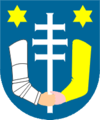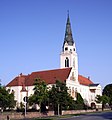Križevci (Croatia)
| Križevci | ||
|
||
|
|
||
| Basic data | ||
|---|---|---|
| State : |
|
|
| County : |
|
|
| Area : | 263.72 km² | |
| Residents : | 21,122 (2011) | |
| Population density : | 80 inhabitants per km² | |
| Telephone code : | (+385) 048 | |
| Postal code : | 48 260 | |
| License plate : | CONCENTRATION CAMP | |
| Structure and administration (status: 2013, cf. ) |
||
| Community type : | city | |
| Mayor : | Branko Hrg ( HSS ) | |
| Website : | ||
 View of Križevci |
||
Križevci [ kriːʒɛʋtsi ] (German Kreutz / Cross , Hungarian Kőrös ) is a north-east of Zagreb located Croatian city. Administratively, the 21,122 inhabitants is one (2011) counting city for County Koprivnica-Križevci .
history
Today's Križevci developed during the Middle Ages in two independent urban settlements: Gornji Križevački grad (Latin: Superior civitas Crisiensis ) and Donji Križevački grad (Latin: Inferior civitas Crisisensis ).
The upper town was in 1193 under King Bela III. first mentioned and in 1252 received the rights of a royal free city from Bela IV . The lower town received this status in 1405 from King Sigismund . As early as the 16th century, the younger lower town had surpassed the upper Križevci in size and population.
On February 27, 1397, the so-called " Bloody Assembly of Križevci " took place. Stjepan II Lacković , the Ban of Croatia , was killed with his supporters by the supporters of Sigismund of Luxembourg.
In 1469, the Croatian-Hungarian King Matthias Corvinus gave Vladislav Hercegović Kosača the fortresses of large and small Kalnik (Veliki i Mali Kalnik) near Križevac.
In the Turkish wars of the late 16th and 17th centuries, the city was fought bitterly several times. Križevci was the birthplace of the Catholic martyr Marko von Križevci , who was murdered by the Calvinists in Košice , Slovakia in 1619 and was canonized soon after . His feast day is always celebrated in the city on September 7th.
In 1752, Empress Maria Theresa merged the upper and lower towns into one commune . Since then, Križevci has had his modern name with the plural ending (Sing. Križevec ). In 1871 the place got a railway connection. The important route from Budapest to Rijeka runs through Križevci. The Gornja Rijeka concentration camp was located in the immediate vicinity during World War II .
Churches
There are eight larger churches from the Middle Ages and the Baroque periods in Križevci. One of them is the Greek Catholic Cathedral of the Most Holy Trinity . It is an old Franciscan church , which was redesigned for the Byzantine liturgy of the Greek Catholic Christians in the 18th century after the establishment of the diocese of Križevci and which has been rebuilt several times afterwards. The Zagreb architects Bartol Felbinger and Hermann Bollé built it among others . The pictures in the iconostasis and in the church are works by Ivan Tišov , Celestin Mato Medović and Bela Čikoš-Sesija .
Križevci Cathedral
Town twinning
Sister towns or municipalities of Križevci are:
sons and daughters of the town
- Johann Vitez (1408–1472), Bishop of Großwardein and Archbishop of Gran
- Marko von Križevci (1589–1619), saint and priest
- Drago Grdenić (1919–2018), chemist and academic
- Dubravko Detoni (* 1937), composer, pianist and author
- Zoran Drvenkar (* 1967), writer
- Vanessa Radman (born 1974), actress
- Leonarda Balog (* 1993), soccer player
Web links
- History of the town of Križevci (Croat.)
- Link of the city of Križevci (croat.)
- Information link about the town of Križevci (Croatian)
proof
- ^ Kosača, Vladislav Hercegović | Hrvatska enciklopedija. Retrieved January 1, 2018 .
- ^ City website , accessed May 6, 2017





